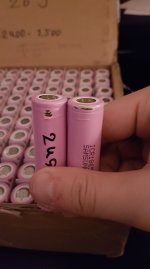I am looking for help to design a battery pack, or mainly some guidelines so i don't screw up instantly. I am going to start "easy" since there is a lot of them used out there, namely the 18650 Lithium cell. why i choose used (tested) cells is mainly price if u do manage to screw up, at least it was used cells and not brand new ones.
But i am not sure of what would be the more economical / best chooise of a BMS for my application, so i am in need of help on the way before i order something.
Lets first start with the spec, it's not going to be a very small battery pack, it will need to at least be able to put out 1500w nominal effect, and ideally up to 3.3kw (to be able to use it as an EV car extension charger if nessessary).
What i find out there in general with the BMS i find on e-bay is that if you go somewhere in the size of 13S or 16S you can find those that will allow anywhere between 60-100A and be well in the range of what i want to put out from the BMS, but when u get into the 48-60V range you get very limited on inverters to get you up to 240V AC and in the 3+kw range. And if you get into the 12/24V inverters the 12-24V BMS systems are not close to the output of 3kw
So the question is how should i face this problem? Is there any soulutions to parallel couple inverters to get a higher output (more amps but same voltage), is there a reasonable solution to paralell couple bms to achive an higher nominal current, or am i simply stuck with very limited options?
I see that there are some high voltage bms systems out there, that well exceeds 240V DC, but the price gets higher, a 64S bms and upwards isn't cheap. but for charging up an car EV battery maybe it could be a solutions to do so with a high voltage bms, but then i lose the ability to use it for other applications that require 240V AC.
So, help please? where can i find compatable bms - inverters for my goal?
(There is an option with a 110V (will charge the PHEV car, but a lot slower) inverter that just takes 15A, that's just a bit shy of 1700w, will charge the car, but all other applications i want to run requires 240v (like car pre-heater etc)
But i am not sure of what would be the more economical / best chooise of a BMS for my application, so i am in need of help on the way before i order something.
Lets first start with the spec, it's not going to be a very small battery pack, it will need to at least be able to put out 1500w nominal effect, and ideally up to 3.3kw (to be able to use it as an EV car extension charger if nessessary).
What i find out there in general with the BMS i find on e-bay is that if you go somewhere in the size of 13S or 16S you can find those that will allow anywhere between 60-100A and be well in the range of what i want to put out from the BMS, but when u get into the 48-60V range you get very limited on inverters to get you up to 240V AC and in the 3+kw range. And if you get into the 12/24V inverters the 12-24V BMS systems are not close to the output of 3kw
So the question is how should i face this problem? Is there any soulutions to parallel couple inverters to get a higher output (more amps but same voltage), is there a reasonable solution to paralell couple bms to achive an higher nominal current, or am i simply stuck with very limited options?
I see that there are some high voltage bms systems out there, that well exceeds 240V DC, but the price gets higher, a 64S bms and upwards isn't cheap. but for charging up an car EV battery maybe it could be a solutions to do so with a high voltage bms, but then i lose the ability to use it for other applications that require 240V AC.
So, help please? where can i find compatable bms - inverters for my goal?
(There is an option with a 110V (will charge the PHEV car, but a lot slower) inverter that just takes 15A, that's just a bit shy of 1700w, will charge the car, but all other applications i want to run requires 240v (like car pre-heater etc)


